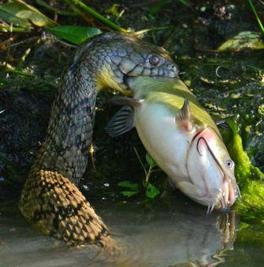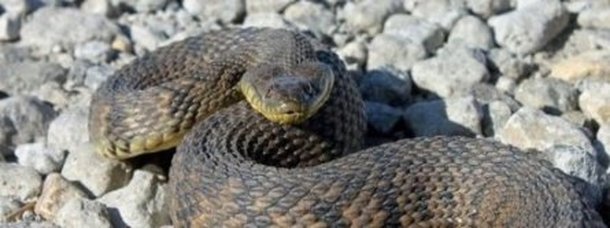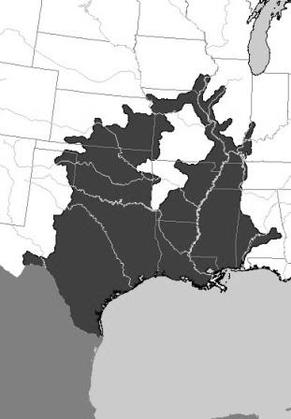Diamondback Water SnakeNerodia rhombifer |

Custom Search
|
The diamondback water snake range includes many of states in the lower Mississippi River Valley, but its distribution extends far beyond that. The species is found within the states of Kansas, in south central Texas, Oklahoma, in southeastern Iowa, Arkansas, Louisiana, Missouri, Illinois, southwestern Indiana, Tennessee, Mississippi, Georgia, and Alabama.
They are also found in northeastern Mexico, along the Atlantic coast, in the states of Nuevo León, Coahuila, Veracruz and Tamaulipas. The diamondback water snake is usually found below 1600 ft (500 m) of altitude but is can reach up to 2450 ft (750 m) They are a habitat generalist, commonly found in a wide array of aquatic habitats margins and shallows of lakes, ponds, rivers, smaller streams, swamps, marshes, canals, water tanks and ditches. The diamondback water snake basks on banks or vegetation, occasionally wandering on land, particularly in wet weather. The diamondback water snake is a fairly large and thick bodied snake, with adult specimens reaching lengths from 3 to 5 feet (91 to 152 cm), with a record length of 8.2 feet (249 cm). On average female snakes tend to be slightly larger and heavier than males. The diamondback water snake dorsal ground color is predominantly brown to dark brown, dark olive green or grayish. A series of dark blotches diamond or rhombus in shape run along the back. These dark blotches are connected on the sides by alternating dark bars, forming a reticulated or diamond-shaped pattern for which they get their common name. The underside of the diamondback water snake is usually orange, olive, yellow or light brown often with dark crescent shaped spots. Like most other colubrid snakes they have round eyes. The diamondback water snake has a rough texture, because of it's heavily-keeled dorsal scales, arranged in 25 or 27 rows at midbody.

If cornered, these snakes will often hiss, and flatten their heads or body to appear larger. Like most other water snakes, the diamondback watersnake has an irritable temperament and will bite repeatedly if harassed or handled.
They are non-venomous so a bite from one is quite harmless, other than a few scratches or lacerations and a possible infection. Even so its bite can be a very painful experience, due to its sharp teeth, designed hold on to slippery fish, their favorite prey. Beside biting diamondback water snakes will also defend themselves by releasing an unpleasant musk and fecal matter, and very nervous individuals will even regurgitate any recent meal. Due to their temperament, pattern and coloration, they are often mistaken for other venomous species like the cottonmouth (water moccasin) or even rattlesnakes, and needlessly killed out of fear. The species is also commonly called diamond-backed watersnake in english and "Culebra de agua de diamantes" in Spanish. We don't really know how long they live in the wild, but captive specimens have lived up to 10 years. The queen snake (Regina septemvittata) is also known as the diamond-back water snake but they aren't related to Nerodia rhombifer the "real" diamondback water snake. Taxonomy / Subspecies Edward Hallowell first described the species as Tropidonotus rhombifer in 1852. Today there are 3 recognized subspecies of the diamondback water snake. Nerodia rhombifer blanchardi (1938) Nerodia rhombifer rhombifera (1852) Nerodia rhombifer werleri (1953) Diet / Feeding The diamondback water snake is a food generalist feeding mainly on various aquatic species, including fish and amphibians but sometimes mammals and reptiles. Their prey includes small and slow fishes, frogs, toads, tadpoles, minnows, salamanders, and crayfish. Occasionally they eat young turtles, worms, leeches, insects even other snakes.The diamondback water snake will also readily feed on carrion as well. The diamondback water snake is an active hunter moving through the shoreline in shallow or even deeper water looking for prey. They are usually diurnal hunters, but may hunt at night on warmer nights. One of their hunting strategies is to swim through a school of fish with their mouths wide open and swallow anything they catch. Other is to herd fish into shallow water and with a coil of its body entrap those fish. The diamondback water snake isn't a constrictor, it will simply swallow the unfortunate prey alive. Reproduction The diamondback water snake is a viviparous species, females don't lay eggs instead give birth to live young. The mating season occurs in Spring, right after the snakes emergence from hibernation. Several males may court one female at the same time. They usually select a spot like a shrub or branch overhanging water for mating but they have been seen breeding on river banks and even in the water. During copulation the male and female make undulating movements and may remain intertwined together for more than an hour or even more. The females give birth in late summer or early fall, from June to October, anywhere from 14 to 62, but the average litter is about 30 to 40 young snakes. The hatchlings measure from 8 to 13 inches (20-33 cm) at birth, and are every bit as irascible as adult snakes. Conservation / Threats The diamondback water snake is listed as a "Least Concern" species by the IUCN, due to their wide distribution and presumed large population numbers. The actual population numbers are unknown but it is probably in excess of 100,000 individuals. The major threat to the species is destruction and degradation of their aquatic habitat. The population declines recorded in the xeric regions of Mexico, are probably caused water diversion for human use or pollution. These snakes are very vulnerable to pesticides. Although some populations in the edge of its range have indeed declined, it has remained stable and even increased in areas where bottomland habitats were inundated by impoundments. Many diamondback watersnakes are killed out of fear, because of their resemblance to other more dangerous venomous snake species.
|
Scientific Classification |
© 2014 Snake Facts About Us | Privacy Policy | Contact




